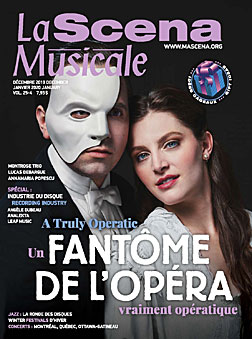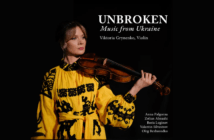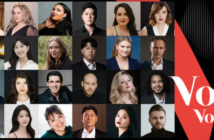
This page is also available in / Cette page est également disponible en:
![]() Francais (French)
Francais (French)
It is an honour to be invited to write the first installment of a new column on arts management for La Scena Musicale, which will be covering the business perspective of the arts, including presenting and touring concerts and multidisciplinary performing arts in Canada. The column will include guest collaborators and special features, covering subjects viewed through the lens of the consumers (audiences, participants) and practitioners (artists, producers, presenters and administrators).
Today’s arts organizations play on a much bigger field than ever. Offerings for excellent arts and leisure activities are diverse and varied, available on multiple channels and platforms, and for the most part, accessible at a very reasonable cost, if not free. Pushed by strong immigration, Canada’s population is growing at a steady rate with baby boomers and their children being the most important consumer groups and influencers. Also, in a marketing environment where we see a fragmentation of the media sector and the multiplication of the digital platforms, today’s consumers’ definition of “culture” is shifting and expanding, along with their core attitudes and behaviours.
 Brand equity wins. Except for celebrities and major entertainment brands, the price of admission and tickets barely sustain incremental increases, putting growing pressure on arts-organization funding and budgets. With the proliferation of online discount resellers (e.g. Travel Zoo), today’s savvy consumers have access to unlimited number of arts and leisure activities never experienced before, and at an incredible price. New technology and digital channels such as Netflix, Amazon, Apple Music, to name a few, have disturbed the former business models and given consumers much easier access to arts and leisure activities and products. The trend even impacts major arts institutions such as the Art Gallery of Ontario (AGO). In a recent bold move, the AGO introduced a pilot project for a new annual membership. The new AGO Annual Pass offers a full year of unlimited access to the AGO collection and all special exhibitions for only $35 (from $145). Visitors 25 and under enter free – all year, anytime. The initiative is supported through public and private funding.
Brand equity wins. Except for celebrities and major entertainment brands, the price of admission and tickets barely sustain incremental increases, putting growing pressure on arts-organization funding and budgets. With the proliferation of online discount resellers (e.g. Travel Zoo), today’s savvy consumers have access to unlimited number of arts and leisure activities never experienced before, and at an incredible price. New technology and digital channels such as Netflix, Amazon, Apple Music, to name a few, have disturbed the former business models and given consumers much easier access to arts and leisure activities and products. The trend even impacts major arts institutions such as the Art Gallery of Ontario (AGO). In a recent bold move, the AGO introduced a pilot project for a new annual membership. The new AGO Annual Pass offers a full year of unlimited access to the AGO collection and all special exhibitions for only $35 (from $145). Visitors 25 and under enter free – all year, anytime. The initiative is supported through public and private funding.
Disposable income and time matter. Today’s consumers have more choice than ever to spend their disposable income and time. According to Statistics Canada, nominal disposable income per capita increased by 2.6% in the past 3 years (2016-2018). Analysis from the Canadian Arts Presenting Association (CAPACOA, 2016), using data measuring the Canadian Wellbeing Index (CWI), demonstrates that Canadians are spending 15% less on culture and recreation. Regardless of whether household income went up or down over the years, the percentage of that total income devoted to culture and recreation remained at approximately 5% to 6% from 1997 to 2008. Following the recession, that percentage fell every year to 4.8% by 2014 — the first time it has been below 5% over the entire 21-year period. While a drop of just under 1% in expenditures for culture and recreation activities appears small, it represents an average decline of almost $6,000 of total household expenditures over that period. The CIW’s analysis however doesn’t take into account recent displacements from leisure expenses to communication expenses: Canadians are accessing more and more content over the internet and communication expenses have seen a significant increase since 2010. Arts and culture participation now represent less than 4% of Canadians’ time. Time spent engaged in arts and culture activities dropped every year from 1994 to 2005. On average, Canadians are spending about one hour less each month engaged in the arts. Since 2005, participation has remained comparatively stable.
Booknet Canada’s recent survey on “most popular activities done daily” reveals that people spend their free time browsing social media/web (60%), watching videos/tv/movies (56%), listening to music (51%), cooking (47%), spending time with family (40%) and reading or listening to a book (25%). Most popular leisure activities done weekly were shopping (35%), dining out (26%) and exercising/working out (20%).
Every three years since 2001, La Placa Cohen, a strategy, design and marketing firm for the creative and cultural world, has conducted a study among an impressive sample of American cultural consumers. For the first time in 2018, the study was conducted in Canada with a total of 6,444 respondents nationwide. Culture Track: Canada sets an important baseline for both understanding the unique proclivities of Canada’s cultural audiences, and for future research efforts that can build on insights first uncovered (see details at laplacacohen.com).
According to Culture Track: Canada, Canadians are cultural omnivores. Rather than define “culture” in narrow terms, audiences view it as inclusive of a broad and diverse set of activities, whether that be a visual art museum, a dining experience, a music festival or a local street fair. Canadians’ relationship with culture is purpose-driven. Specifically, they value experiences that ultimately nurture belonging, empathy, and perspective. This paradigm shift is incredibly important for practitioners, as it can ultimately impact decisions relative to infrastructures, programs and other elements of an art organization. One thing is certain: the competitive landscape has just soared, and the fiercest competitors may not be who you think they are.
Other key takeaways include “relevance” and “relationships.” While fun, novelty and escape are desired attributes of a cultural experience, relevance is a precondition for success. Audiences won’t consider participating if they don’t feel connected to the content or experience. Notably, culture’s unique ability to relieve stress is reported consistently across generations. Whether by providing a calming atmosphere, a seamless visitor experience or accessible content, audiences look to cultural experiences to reduce anxiety, not add to it. Finally, a fundamental shift has occurred in what individuals seek in committing to organizations: they now value empathy and reciprocity. This new relationship-based approach is replacing transactional models.
The influence of demographic trends on arts organizations. According to Statistics Canada, the country’s population is growing steadily, primarily because of immigration. Recent population growth (2018 and 2019) is the highest among G7 countries and the largest increase recorded. Baby boomers now account for the majority of seniors, and there are more than 10,000 centenarians living in Canada! Visible minorities currently count for 22% of the population, trending towards 30% by 2031.
Hill Strategies’ report “Demographic patterns in Canadians’ Arts Participation in 2016” (hillstrategies.com) examine 11 indicators of arts participation and eight arts attendance activities. Good news: the report shows that the arts appeal to a large majority of Canadians in all demographic groups. The strongest pattern in arts participation found in the analysis is that higher education corresponds to higher arts participation. The Hill Strategies and La Placa Cohen reports both offer meaningful insights in consumer trends and align with many findings, including with the frequency of arts participation, found higher in millennials, allophones and people living in urban centres.
Based on demographics, consumers attitudes, behaviors, and market trends, how do arts organizations compete? There is no perfect answer to this question. Nonetheless, Canadian arts organizations will remain competitive by consistently delivering superior and relevant experiences to the right market at the right time and at the right price; by building a robust relationship-based marketing program optimizing digital content and platforms; and by constantly building capacity and developing strategies to diversify revenues in order to strengthen sustainability.
Ultimately, today’s arts organizations should look at a holistic approach to answer the question: what do we really compete for (or against)? Simply expressed, I believe we ultimately compete on three fronts: consumers’ disposable income, consumers’ time and brand equity.
Eric Lariviere is General Manager of Flato Markham Theatre and a Professor at Seneca College in the Event Marketing Graduate program. Please send comments, questions and ideas to [email protected].
This page is also available in / Cette page est également disponible en:
![]() Francais (French)
Francais (French)















